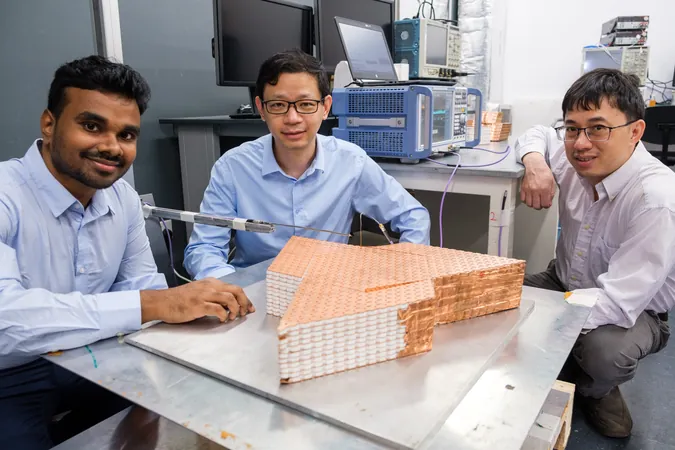
Breakthrough Technique to Illuminate the Enigma of Dark Matter and the Universe
2025-01-09
Author: Ken Lee
Introduction
In an exciting advancement from Nanyang Technological University (NTU) in Singapore, researchers have unveiled a groundbreaking technique that could fundamentally alter our approach to detecting dark matter and understanding the universe's mysteries. This could represent a significant leap towards unlocking the secrets of the cosmos.
Understanding Dark Matter
Scientists estimate that a staggering 85% of the universe is made up of dark matter, an elusive substance that cannot be seen or measured directly. While everything we observe—such as stars, planets, and galaxies—constitutes only a fraction of the universe's total mass, dark matter acts as the unseen glue that holds galaxies together. Understanding dark matter is crucial for constructing a comprehensive picture of cosmic phenomena, which currently elude explanation by visible matter alone.
The Challenge of Detection
The challenge lies in the very nature of dark matter, which does not emit or reflect light and interacts extremely weakly with regular matter. This makes it incredibly difficult to detect using existing scientific instruments.
Axions: A Candidate for Dark Matter
Among the leading candidates for dark matter particles is the axion, a theoretical particle that physicists have been trying to identify for over 40 years. The quest to observe axions has focused on demonstrating that existing particles, like electrons, can mimic their behavior. While this approach has yielded inconclusive results until now, NTU's researchers have potentially changed the game.
The Experiment and Its Findings
In a remarkable experiment, they found that photons, the light particles, can behave like axions. This was accomplished through their specially designed crystal structures, crafted to manipulate how light travels. As they observed, photons in their crystals moved in a manner consistent with the predicted behavior of axions.
Insights from the Lead Researcher
Professor Zhang Baile, who spearheaded the research, expressed optimism, stating, 'The findings from our new crystal structures give us more confidence that we could one day use these crystals to detect real axions.' He emphasized that this work could provide a pathway to decrypt some of the universe's most profound secrets.
Historical Context of Dark Matter Research
Historically, dark matter's existence was first proposed in the 1930s to explain why galaxies did not tear themselves apart despite their rapid rotation. The axion, first theorized in the late 1970s by physicists like Roberto Peccei and Helen Quinn, emerges from theories attempting to solve critical issues in particle physics. If axions indeed make up dark matter, they are expected to have originated shortly after the Big Bang during the universe's rapid expansion.
Challenges and Innovations in Detection
Although detecting axions directly remains challenging, they are theorized to convert into photons under specific conditions, such as in a strong magnetic field. However, this conversion process is low in efficiency, making detection difficult. The innovative work by NTU's team offers a new strategy, focusing on how photons can exhibit axion-like behavior in engineered materials.
Materials and Methodologies Used
The team employed yttrium iron garnet, a material with unique magnetic and optical properties, to construct crystalline geometric structures that allowed photons to move with minimal scattering. This behavior aligns with theoretical predictions for axions and suggests potential pathways toward future detection methods.
Future Implications of the Research
As they aim to optimize these crystal designs for enhanced sensitivity, the researchers believe their work could not only enhance our understanding of dark matter but also improve data transmission and quantum computing technologies. The findings may lead to the development of more reliable quantum computers and communication systems, leveraging the unique properties of the photons manipulated by these special crystals.
Expert Opinions and Recognition
The significance of this study has been recognized beyond NTU, with experts like Professor Yannis Semertzidis from the Korea Advanced Institute of Science and Technology commending the research as a pivotal breakthrough in the search for axion dark matter. He praised the crystal structures as one of the most promising alternatives for detecting this elusive substance.
Conclusion
As we stand on the brink of a new era in astrophysics, this research could illuminate our understanding of the universe, providing not just theories but tangible methods to explore its deepest mysteries. The quest to unveil the intricacies of dark matter is far from over, but with innovative approaches like this, we may be one step closer to understanding the cosmos in all its complexity.

 Brasil (PT)
Brasil (PT)
 Canada (EN)
Canada (EN)
 Chile (ES)
Chile (ES)
 Česko (CS)
Česko (CS)
 대한민국 (KO)
대한민국 (KO)
 España (ES)
España (ES)
 France (FR)
France (FR)
 Hong Kong (EN)
Hong Kong (EN)
 Italia (IT)
Italia (IT)
 日本 (JA)
日本 (JA)
 Magyarország (HU)
Magyarország (HU)
 Norge (NO)
Norge (NO)
 Polska (PL)
Polska (PL)
 Schweiz (DE)
Schweiz (DE)
 Singapore (EN)
Singapore (EN)
 Sverige (SV)
Sverige (SV)
 Suomi (FI)
Suomi (FI)
 Türkiye (TR)
Türkiye (TR)
 الإمارات العربية المتحدة (AR)
الإمارات العربية المتحدة (AR)